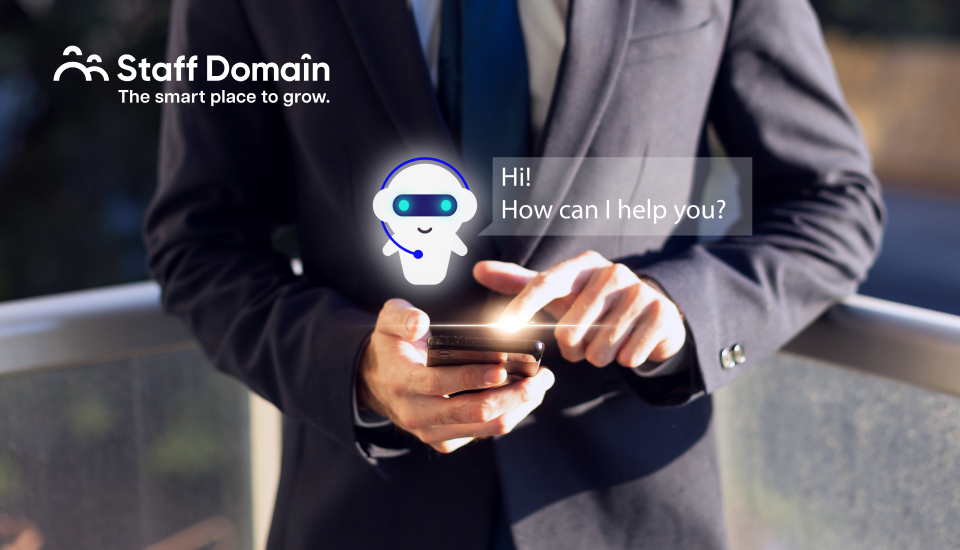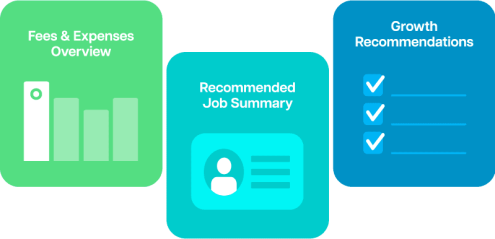As technological advancements reshape the business landscape, companies continue to harness the power of tech-support services to enhance their operations and customer interactions. One notable example is the integration of chatbots into their customer service strategy.
The chatbot market expands at 23.3 per cent annually and is predicted to reach $15.5 billion by 2028. This demand for chatbots reflects the preference of enterprises to automate simple customer support tasks and aid customer service representativesto focus on delivering personalised assistance to customers across various channels.
At Staff Domain, we believe in utilising the right tools to enable our offshore workforce to work smart. While chatbots make simple tasks efficient, they can be a significant investment, particularly for small-to-medium enterprises. To help businesses decide if chatbots are essential for their customer service, we share this guide outlining the pros and cons of implementing chatbots and whether they are the right fit for the business’s customer service arsenal.
Chatbots come with certain advantages and limitations that are important to consider before integrating them into customer service. By weighing these factors, businesses can make informed decisions about their implementation. Here are some of them:
Pros and Cons of Using Chatbots
- Round-the-clock support
One main advantage of chatbots are its 24/7 availability. They provide instant customers support regardless of time zones or business hours. This convenience ensures that customers can receive support whenever they need it, enhancing overall customer satisfaction and loyalty.
- Adaptability to customer inquiry spikes
Chatbots can efficiently manage numerous conversations simultaneously. This scalability allows businesses to handle spikes in customer inquiries without requiring additional resources. This assures that service levels are consistent during peak periods.
- Cost efficiency in operations
Implementing chatbots can lead to significant cost savings for businesses by reducing the reliance on large customer support teams. Chatbots handle high volumes of inquiries, and with the support of human agents, organisations can allocate resources more efficiently and streamline operational expenses.
- Quick response times
Chatbots provide instantaneous responses to customer queries. This eliminates the need for customers to wait in queues or endure lengthy response times. Having a swift ticket turnaround enhances the overall customer experience as issues are addressed promptly, thereby preventing customer frustration or dissatisfaction.
- Consistent responses
Chatbots deliver consistent responses to inquiries, ensuring uniformity in information provided to customers across all interactions. This works particularly for commonly asked questions. This consistency reduces the need for repeated clarifications and ensures that customers receive accurate and reliable assistance every time they engage with the chatbot.
Risks to utilising chatbots
Pros to utilising chatbots
- Limitations in understanding complex queries
Despite advancements in natural language processing (NLP) technology, chatbots still struggle to comprehend complex inquiries. Certain conversational tools still find it difficult to understand nuances in language, which leads to misinterpretations or incomplete responses. This limitation can frustrate customers who expect precise and contextually relevant answers to their queries.
- Impersonal interactions
Unlike human agents who can empathise with customers’ emotions and tailor their responses accordingly, chatbots lack emotional intelligence and interpersonal skills. As a result, interactions with chatbots may feel detached and robotic, particularly when addressing sensitive issues or queries that need empathetic support.
- High initial investment
Developing and implementing chatbot technology requires a significant initial investment of time, resources, and expertise. Businesses need to allocate funds for software development, training, and ongoing maintenance to ensure the effectiveness and reliability of the chatbot solution. This upfront cost may deter some organisations from adopting chatbots, particularly smaller businesses with limited budgets.
- Technical issues and glitches
Chatbots are susceptible to technical glitches, errors, and system outages, which can disrupt the customer experience and undermine customer confidence. Common issues such as inaccurate responses, system crashes, or integration failures can result in customer frustration and dissatisfaction, potentially leading to negative perceptions of the brand.
- Dependency on data quality
Chatbots rely heavily on high-quality data and content to deliver accurate and relevant responses to customer inquiries. Inaccurate or outdated information can undermine the effectiveness of the chatbot and lead to confusion or misinformation. Maintaining data integrity and regularly updating knowledge bases are essential to ensure the chatbot remains reliable and valuable to customers.
Considerations When Adding Chatbots for Customer Service
- Complexity of inquiries
Evaluate the nature of customer inquiries to determine if chatbots can effectively address them. Simple, repetitive inquiries are well-suited for automation, while complex issues may require human intervention.
- Budget and resources
Assess the organisation’s budgetary constraints and available resources to determine if investing in chatbot technology is feasible. Consider the long-term return on investment (ROI) and potential cost savings versus the initial investment.
- Integration with existing customer service channels
Ensure seamless integration of chatbots with the business’s existing channels. These can include channels such as live chat support and self-service portals, to provide a cohesive and efficient customer experience.
- Customer demographics
Understand the business’s customer demographics and preferences to gauge their receptiveness to chatbot interactions. Younger demographics may be more comfortable interacting with chatbots, while older demographics may prefer human assistance.
What Should Be in Your Customer Service Arsenal
While chatbots are an effective tool for customer service, they are just one component of a comprehensive customer service arsenal. For a well-rounded customer service approach, a business should consider incorporating the following tools and implementations:
- Live Chat Support
Live chat support is a cornerstone of modern customer service strategies. It offers real-time assistance through text-based communication. Staffed by customer service representatives, live chat enables personalised interactions, immediate problem-solving, and empathetic support. It allows customers to engage with knowledgeable representatives who can address complex inquiries, provide product recommendations, and offer assistance throughout the purchase journey. It enhances customer satisfaction by fostering meaningful connections and resolving issues efficiently, which leads to positive brand experiences. - Outsourced Customer Service Representatives
According to the interactive content platform, Outgrow, 60 per cent of consumers still prefer to wait in queue for a human agent than to receive an instant reply from a chatbot. This statistic highlights the unceasing importance of having an Outsourced customer service representatives on the team who can cater to customers who want to speak with a real agent.Outsourced customer service representatives are trained professionals equipped with the necessary skills and knowledge to handle various customer interactions, ranging from general inquiries to technical support issues. Hiring an offshore staff offers a flexible, cost-effective solution for businesses to manage customer inquiries and support operations.By partnering with a reputable outsourcing company, businesses can access a global talent pool, scale their customer capabilities, and ensure consistent service levels across different channels. Outsourced representatives complement internal teams, especially during peak demand periods or when additional language support is required, enhancing overall customer experience and retention. - Self-Service Portals
Self-service portals empower customers to find solutions independently by accessing a range of self-help resources and tools. These portals typically include FAQs, knowledge bases, troubleshooting guides, video tutorials, and community forums where customers can search for answers, troubleshoot issues, and share experiences with other users.Self-service portals enhance customer empowerment, promote product adoption, and alleviate strain on customer service teams by redirecting routine inquiries, thereby improving operational efficiency.
Should You Use Chatbots for Customer Services?
Customer expectations are always evolving and using chatbots is an innovative solution to enhancing customer support experience. Yes, businesses should consider chatbots for their customer services. They can provide fast and efficient support, handle basic inquiries, and help human agents focus on more complex issues. However, it is important to also consider potential drawbacks. After all, most customers still prefer engaging with human agents. The high-quality customer care provided by human representatives significantly enhances customer satisfaction and retention.
In an era where artificial intelligence plays a decisive role in customer service, it is a smart move to integrate chatbots in the business strategy. To maximise its benefits to one’s business operations, make sure to partner with a dedicated customer service representative that can guarantee the chatbot’s accuracy of responses and maintain its efficiency.
Team up with a leading offshore outsourcing company that outsources highly skilled professionals. This will ensure that the business works with highly qualified experts exposed to advanced tools and who have years of international experience within their field.
Staff Domain’s offshore outsourcing solutions connect your business to a highly experienced global talent pool for game-changing results. Effortlessly manage your offshore workforce with our comprehensive compliance, payroll, and HR support, and benefit from fixed, transparent pricing in your local currency. Contact us today or schedule a meeting with our sales team to quickly source the right offshore team for your business.
FAQs
How can chatbots maintain a personalised customer experience?
Chatbots can use customer data from previous interactions or customer relationship management (CRM) systems can be integrated that allows access to relevant customer information. Some chatbots also utilise natural language processing (NLP) to simulate natural conversations with the customers.
Will incorporating chatbots replace human agents?
No. Chatbots are created to help human agents deliver high-quality customer experience. While they are useful for simple tasks and basic inquiries, human agents are still essential for handling complex issues and building relationships with customers.
How can businesses ensure that their chatbots align with their brand voice and values?
Enterprises should invest time in honing the language and tone the chatbot uses. Provide guidelines for the chatbot developers to ensure the brand voice and values are consistently reflected in all customer interactions.
How can businesses measure the success and effectiveness of their chatbot implementation?
Evaluation through key performance indicators (KPIs) is one way for businesses to measure the effectiveness of their chatbot. They can also gather customer feedback to gain insight into areas of improvement for customer service.
What are the long-term implications of integrating chatbots into the customer service ecosystem?
As technology continues to play a pivotal role in business operations, businesses can explore and reshape customer service dynamics through chatbots to remain competitive in the market. It allows enterprises to handle increasing customer demands without having to increase resources.









